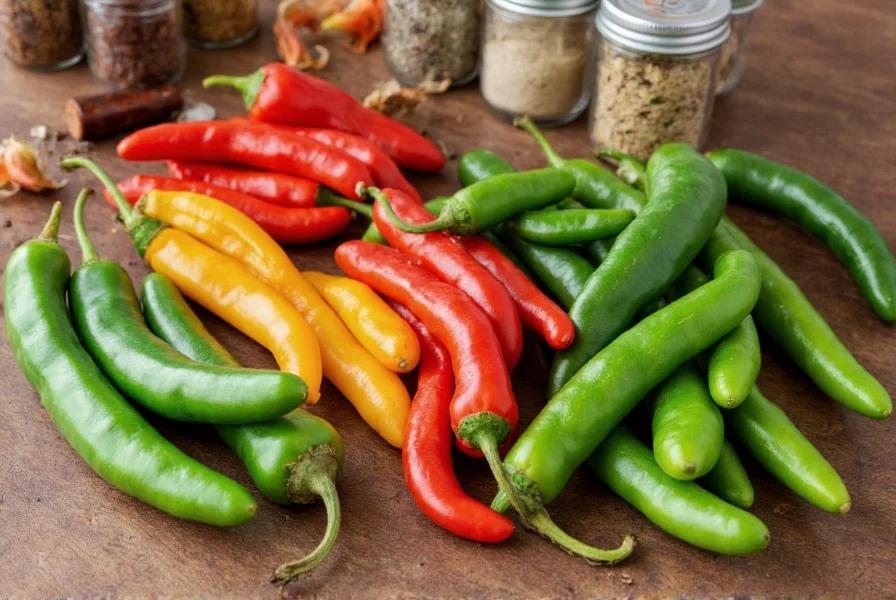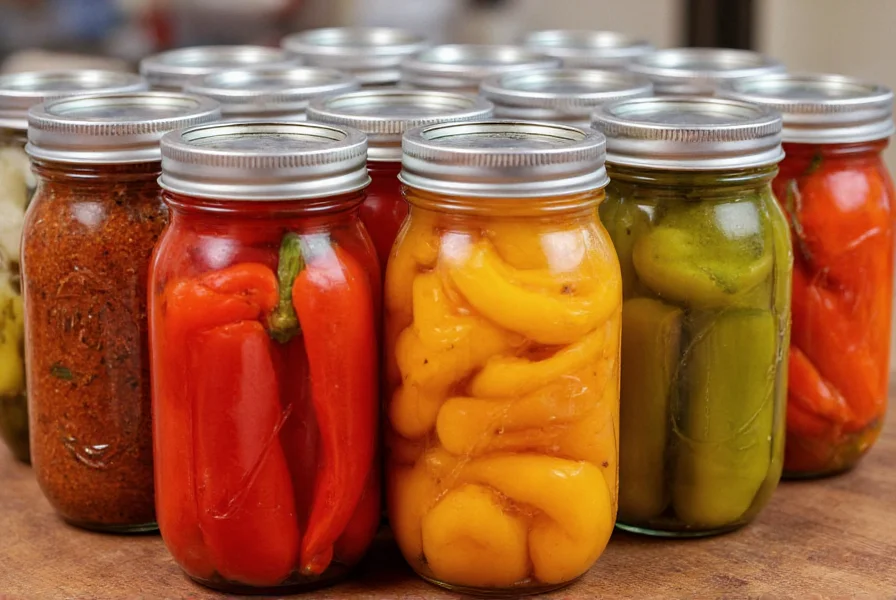Preserving peppers through pickling transforms seasonal harvests into versatile kitchen staples that enhance sandwiches, tacos, and charcuterie boards year-round. This ancient preservation method leverages acidity to inhibit bacterial growth while infusing peppers with complex flavors. Whether you're working with garden-fresh jalapeños or supermarket bell peppers, understanding the science behind successful pickling ensures crisp, flavorful results every time.
The Science Behind Successful Pepper Pickling
Pickling works through acidification—typically using 5% acidity vinegar—which creates an environment too hostile for harmful bacteria. The ideal pH range for safe pickled peppers is 3.4-4.6. When vinegar concentration drops below 5%, spoilage risks increase significantly. Proper salt usage (1-2 tablespoons per pint) draws out excess moisture while enhancing flavor penetration without compromising safety.
Two primary methods exist for home pepper pickling: refrigerator pickles for immediate consumption and water bath canning for long-term storage. Refrigerator versions skip the canning process, requiring only 24-48 hours of brine infusion before use. Water bath canning creates vacuum-sealed jars through boiling water submersion, enabling shelf-stable storage for up to 18 months when processed correctly.
Best Pepper Varieties for Pickling Projects
Not all peppers respond equally to pickling. Their cellular structure, water content, and heat levels significantly impact final texture and flavor absorption. Consider these characteristics when selecting peppers for your pepper pickling recipe:
| Pepper Type | Heat Level (SHU) | Pickling Suitability | Flavor Notes |
|---|---|---|---|
| Jalapeño | 2,500-8,000 | Excellent (holds shape) | Grassy, vegetal notes intensify |
| Banana Pepper | 0-500 | Excellent (crisp texture) | Sweet-tart profile develops |
| Bell Pepper | 0 | Good (softer result) | Mellows to sweet tanginess |
| Serrano | 10,000-23,000 | Good (shrinks slightly) | Intense heat mellows beautifully |
| Habanero | 100,000-350,000 | Fair (becomes very soft) | Fruity notes shine through heat |
For optimal results in pepper pickling at home, select firm, blemish-free peppers harvested at peak ripeness. Late summer through early fall provides the best quality for most varieties. Avoid overripe peppers with soft spots, as they'll break down during processing. Smaller peppers like Hungarian wax or padrón often pickle more evenly than large bell peppers, which benefit from being cut into uniform strips.

Step-by-Step Pepper Pickling Process
Follow this tested method for crisp, flavorful pickled peppers that maintain quality throughout storage:
- Preparation: Wash 2 pounds of peppers thoroughly. Remove stems and seeds (keep seeds for extra heat). Slice uniformly—rings for jalapeños, strips for bells.
- Brine Creation: Combine 2 cups 5% acidity vinegar, 2 cups water, 2 tablespoons pickling salt, and 1 tablespoon sugar in a non-reactive pot. Add flavor enhancers: 4 garlic cloves, 1 tablespoon black peppercorns, 1 teaspoon red pepper flakes.
- Processing: Bring brine to rolling boil. Pack peppers tightly into sterilized pint jars, leaving ½ inch headspace. Pour hot brine over peppers, maintaining ¼ inch headspace.
- Canning (for shelf-stable): Wipe rims, apply lids, process in boiling water bath for 10 minutes. Refrigerator method: Cool completely, then refrigerate after 24 hours.
Proper pepper canning techniques prevent common issues like siphoning (liquid loss during processing) and cloudiness (often from using table salt with anti-caking agents). Always use pickling or canning salt for crystal-clear brine. The vinegar-to-water ratio must never drop below 1:1 for safe preservation—never reduce vinegar in favor of water.
Flavor Customization Options
Once you've mastered basic pepper pickling recipes, experiment with these flavor variations:
- Spicy-Sweet Version: Add ½ cup honey and 2 cinnamon sticks to brine
- Mexican-Style: Include 1 sliced onion and 1 teaspoon cumin per jar
- Garlic-Dill: Substitute dill seeds for peppercorns with extra garlic
- Tropical Twist: Add 2 star anise pods and 1 sliced mango per quart
Allow flavors to develop for at least two weeks before consumption for best results. The vinegar's sharpness mellows while peppers fully absorb surrounding flavors. Store opened jars in the refrigerator for maximum freshness.

Troubleshooting Common Pickling Problems
Even experienced preservers encounter issues. Here's how to address frequent pepper pickling problems:
- Soft Peppers: Caused by overprocessing or using overripe produce. Add ¼ teaspoon calcium chloride (Pickle Crisp) per jar to maintain crunch.
- Cloudy Brine: Usually from minerals in table salt or hard water. Always use pickling salt and filtered water for crystal-clear results.
- Siphoning: Liquid loss during processing occurs from improper headspace or rapid temperature changes. Maintain precise headspace measurements and cool jars gradually.
- Mold Growth: Indicates improper sealing or insufficient acidity. Discard affected batches immediately—never attempt to salvage moldy pickles.
Safety Considerations for Home Preservation
While safe pepper canning methods are straightforward, critical safety steps prevent foodborne illness:
- Always use tested recipes with verified vinegar concentrations (minimum 5% acidity)
- Process pint jars in boiling water bath for 10 minutes at sea level (adjust for altitude)
- Check seals after 24 hours—lids should not flex when pressed
- Discard any jars with bulging lids, off-odors, or visible mold
- Refrigerate after opening regardless of canning method
Never alter vinegar-water ratios in tested recipes, as this compromises safety. The National Center for Home Food Preservation confirms that vinegar concentration below 5% creates unsafe pH levels for low-acid vegetables like peppers. When in doubt about a batch's safety, discard it—food poisoning risks far outweigh the value of questionable preserves.
Storage and Usage Guidelines
Properly stored pickled peppers maintain quality for specific durations:
- Water bath canned jars: 12-18 months in cool, dark place (55-70°F)
- Refrigerator pickles: 1-2 months
- Opened jars: 2-3 weeks refrigerated
Peak flavor typically develops at 4-6 weeks post-processing. Use pickled peppers to elevate grilled meats, egg dishes, sandwiches, and cheese boards. The brine itself makes excellent marinade base or cocktail ingredient—try it in Micheladas or Bloody Marys for authentic flavor.
What's the minimum vinegar concentration needed for safe pepper pickling?
You must use vinegar with at least 5% acidity for safe pepper pickling. Lower concentrations create unsafe pH levels that allow harmful bacteria growth. Always check the label—do not substitute lower-acidity vinegars like wine or rice vinegar without adjusting quantities to maintain proper acidity levels.
Why do my pickled peppers become soft after processing?
Soft pickled peppers usually result from overprocessing, using overripe produce, or insufficient calcium. To maintain crispness, process jars only for the recommended time (10 minutes for pints), select firm peppers, and add ¼ teaspoon calcium chloride (Pickle Crisp) per jar before processing.
Can I use table salt instead of pickling salt for pepper pickling?
No, table salt contains anti-caking agents that cause cloudy brine and may affect flavor. Always use pure pickling or canning salt without additives for clear, professional-quality results. Sea salt works as an alternative if it's additive-free, but may contain minerals that slightly cloud the brine.
How long should I wait before eating homemade pickled peppers?
For best flavor development, wait at least 2 weeks before consuming pickled peppers. The vinegar's sharpness mellows while peppers fully absorb surrounding flavors. Refrigerator pickles can be eaten after 48 hours, but still benefit from 1-2 weeks of marinating time for optimal taste.
What causes cloudy brine in pickled peppers and is it safe?
Cloudy brine typically comes from minerals in table salt, hard water, or spice particles. While usually harmless, it can indicate spoilage if accompanied by off-odors or mold. Prevent cloudiness by using pickling salt, filtered water, and cheesecloth bags for loose spices. Discard any batch with suspicious odors or visible mold growth.











 浙公网安备
33010002000092号
浙公网安备
33010002000092号 浙B2-20120091-4
浙B2-20120091-4